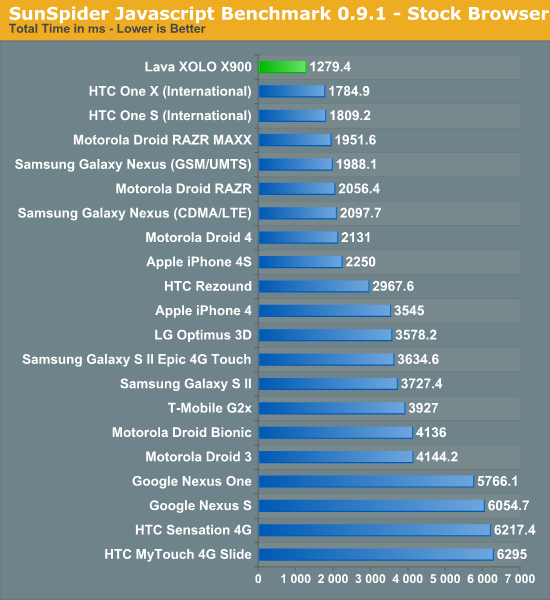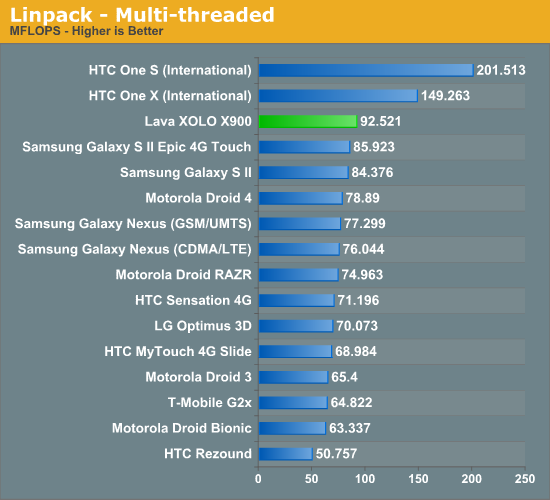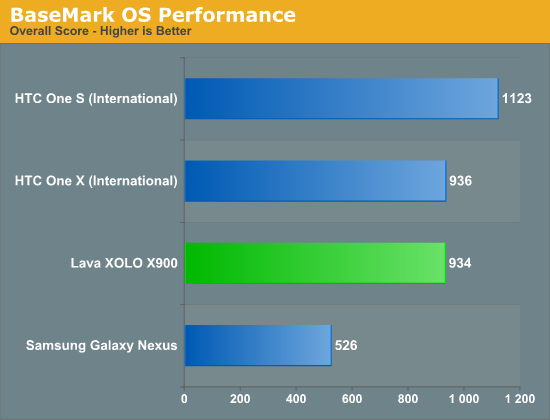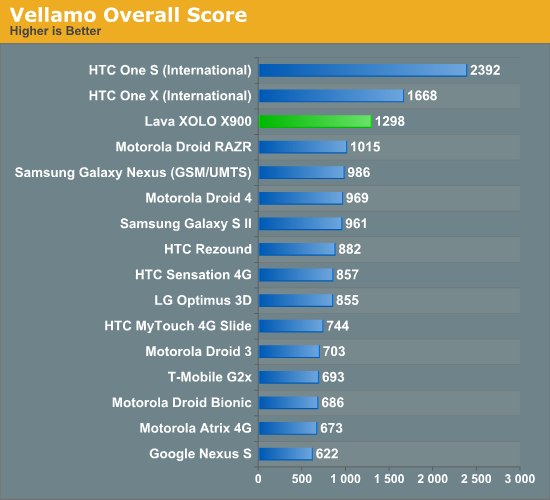Lava Xolo X900 Review - The First Intel Medfield Phone
by Brian Klug on April 25, 2012 6:00 AM ESTJavascript Performance
Although smartphones are clearly headed for a life beyond simple messaging, web browsing and phone duties, we are still lacking the tools to measure performance in areas other than a component of web page rendering. Measuring javascript performance is one component of the entire web page rendering process but it's the most mature in terms of something we can benchmark.
Sunspider is quite possibly the most well known of these javascript tests, and it also happens to be one that runs extremely well on Medfield:

The Lava phone is just a tad faster than the FFRD we tested at the beginning of the year, which may not sound like much but is positive given that Mike Bell was very confident that all Intel FFRD phones would deliver the same level of performance. The X900 ends up being the fastest smartphone we've ever tested here. Intel won't be able to claim that title in any other benchmark here today but it's an impressive feat for just now showing up to the game. It's also worth pointing out that Intel is able to do this well running on Gingerbread, while its closest competition are running on Ice Cream Sandwich with far improved JS performance built into the browser.
Why is Medfield so much faster here? It's tough to say, but likely a combination of reasons. Google's V8 engine has had a ton of optimization work done around x86 to begin with. By virtue of nearly every computing platform that runs a Google browser outside of Android being x86, it's natural that some of those optimizations are going to transition over into Android for x86 as well. That's actually a part of a much larger advantage Intel has should x86 take off in the smartphone space.
On a more technical hardware level, Intel claims its cache and memory interfaces are simply better than the competition here - which in turn results in a significant performance jump in Sunspider.
BrowserMark is another js benchmark in our suite, but here the advantage has been reduced to simply competitive with the fastest phones in our labs:

For a single Atom core running Gingerbread, Medfield does very well here - roughly equaling the performance of NVIDIA's Tegra 3 (HTC One X) and Qualcomm's Snapdragon S4 (HTC One S). It's quite possible that when running ICS Medfield will once again step ahead of the competition, but even if this is as good as it gets it's a good start. Keep in mind that we're looking at a 4 year old microprocessor architecture running on a n - 1 process from Intel.
Low Level FP Performance
Linpack isn't a great indication of smartphone performance, but it is a good test of the floating point capabilities of the CPUs in these SoCs. ARM has steadily been improving FP performance for the past few generations but we're going to see a big jump to Krait/A15. As most client smartphone workloads are integer based and those that are FP heavy end up relying on the GPU, an advantage here doesn't tell us much today (particularly because Linpack isn't running native code but rather atop Dalvik) other than how speedy the FPUs are:

Single threaded FP performance is very good on Medfield as you'd expect, but a bit lower than Qualcomm's Snapdragon S4. As Krait is a wider, out-of-order architecture with a fairly reasonable FPU the 13% advantage here isn't too surprising. Compared to anything A9 based however, Medfield is obviously quicker.
Linpack, like many scientific workloads, scales up to multiple cores quite nicely. If we spawn as many threads as there are logical cores (2 for Intel and Qualcomm, but 4 for NVIDIA's Tegra 3) we can see how Intel's single-core Atom fares in a multithreaded world:

There's roughly no change in Medfield's performance here, which will be an issue for any compute heavy, very threaded application. Luckily for Intel, not many of these types of applications exist on smartphones today, but it is a limitation of this first generation Medfield. Hyper Threading is a great way to increase CPU utilization power efficiently, but for some workloads there's no replacement for more cores. Snapdragon S4 does extremely well here in the HTC One S by being a combination of two cores and having a much faster FPU.
BaseMark OS
Rightware's BaseMark OS is a general purpose benchmark designed to better simulate overall Android performance. It includes a heavily threaded benchmark, file IO tests, and compression/decompression tasks that all contribute to its overall score. We only have results from the HTC One S (Snapdragon S4), One X (Tegra 3), Galaxy Nexus (OMAP 4) and the Lava phone (Medfield) here:

At least in BaseMark OS, Intel's performance is distinctly modern although not at the head of the class. Differences in performance here extend beyond the SoC and are obviously influenced by things like NAND selection as well as the OS on the device. For many of these benchmarks I'm very curious to see how they change with the arrival of Ice Cream Sandwich.
Vellamo
Vellamo is a Qualcomm developed benchmark that focuses primarily on browser performance, both in rendering and UI speed. The results are heavily influenced by the browser used on the device being tested. As a whole Vellamo isn't always indicative of whether or not you're going to get a smooth browsing experience, but it's another datapoint that captures more than just javascript performance. The Qualcomm-developed nature of the benchmark is always cause for concern, but even if you exclude the Snapdragon results the benchmark can be useful:

Once again we have a good showing from Intel. The X900 and its Medfield soul aren't the fastest, but Intel's first smartphone is in the top three and faster than almost everything that came before it. Much of the advantage here actually comes from the Google V8 benchmark, another js test, which we've already established Intel can do quite well in.
Flash Rendering Performance
These days nearly all high-end smartphones (I refuse to call them superphones) can render Flash smoothly. Thankfully Intel's platform is no exception as the X900 delivers a competitive showing in our Flash benchmark:











106 Comments
View All Comments
tipoo - Wednesday, April 25, 2012 - link
Looks like Krait still has a significant lead over Intels competitor, and it was shipping sooner. Intels doesn't have better CPU performance, GPU performance, or battery life, it's just ok at everything. I think their advantage will no doubt grow with 22nm, but for now we finally see Intel entering some stiff CPU competition, even if its for the low power draw segment.Lucian Armasu - Wednesday, April 25, 2012 - link
That's the question: why would manufacturers care? Just because it's Intel? And why would they want to repeat the PC situation where they got an Intel lock-in, when there's much better competition with ARM makers, and they can get the chips for a much cheaper price (which Brian didn't take into account in this review).haar - Wednesday, April 25, 2012 - link
<strong> But, can it play Crysis? </strong>. ROFLMAO! (sorry, first and last time i will use this... but really it is a perfect line imao)y2kBug - Wednesday, April 25, 2012 - link
It seems that Intel put a lot efforts to make Android run on x86. Even if I think that this will not bring Intel any money in return; here is an idea how to make these efforts not to die in vain. Make this runtime work on Windows, so that we can run Android apps on the upcoming Windows 8 tablets. This will make upcoming Windows 8 tablets so much more useful from the very start.superPC - Wednesday, April 25, 2012 - link
YouWave ( http://youwave.com/ ) and BlueStack ( http://bluestacks.com/ ) can already do that on windows 7 right now. BlueStack has shown that it can run android apps on windows 8 PC (it just doesn't have live tiles http://www.youtube.com/watch?v=SKAOkpX7Q2E ).aegisofrime - Wednesday, April 25, 2012 - link
Am I the only one who can't wait for an Android phone rocking ULV Haswell? That is gonna be such a beast. Modern in-order architecture + hopefully decent GPU.tipoo - Wednesday, April 25, 2012 - link
Yeah, Atom is quite an old architecture now in chip terms, a redesign could bring Intel back up in a huge way. While I was disappointed by this SoC, bearing in mind how old it is and its competing against new designs like Krait, I guess they could do much much better with a real new Atom.Khato - Wednesday, April 25, 2012 - link
Whereas my guess is that we'll be seeing conroe-class performance out of the silvermont cores in Medfield's successor. Hence why I couldn't help but chuckle at the second to last line in the review, "What I'm waiting for is that Conroe moment, but in a smartphone."tipoo - Wednesday, April 25, 2012 - link
Conroe class performance would certainly bring these devices up to "good enough" territory. But current Atoms are only a fraction that performance still. We'll have to wait and see I guess.B3an - Thursday, April 26, 2012 - link
You're both idiots if you think Intel could get Conroe class or vastly better Atom performance out of 32 or 22nm.The whole reason Intel have used the 'old' Atom design in the first place is because it's simple and small, which means lower transistor count, smaller die, and lower power consumptions. If you honestly think they could have got Conroe level complexity or performance in a phone SoC with anywhere near acceptable power consumption and die size, even at 22nm, then you're both living in a fantasy universe.